These hot and fast smoked baby back ribs are ready in under 3 hours with bold smoke flavor, a rich bark, and a sticky, caramelized glaze — all straight from the pellet grill.
Baby backs cook quicker than spares, and when paired with a tangy Carolina vinegar sauce, you get tender, meaty ribs without the all-day wait.
Can you really smoke ribs in under 3 hours?
With the right method, you can absolutely smoke ribs in under 3 hours and still get tender, flavorful results using a hot and fast smoking technique.
At this higher temp, fat renders more quickly, bark develops faster, and smoke still infuses the meat during the critical early stage of the cook. Baby back ribs are perfect for this approach — they’re smaller, leaner, and naturally cook faster than spares.
Wrap them tightly to braise, finish with a high-heat glaze, and you’ll end up with juicy ribs that have bite, bold smoke flavor, and a caramelized glaze — all in a fraction of the time it usually takes.
Ingredients for hot and fast smoked ribs
- Baby back ribs – Smaller and leaner than spare ribs, ideal for hot and fast smoking. Look for racks with good marbling and minimal surface fat.
- Dry rub – Use a pork-friendly blend with plenty of sweetness and a hint of heat. Save time with a store-bought pork rub, or make up a batch of our ultimate rib rub.
- Yellow mustard or binder (optional) – Acts as a glue for the rub. Mustard adds a subtle tang but won’t affect flavor after smoking.
- Wrapping ingredients – A mix of apple juice, brown sugar, honey, and unsalted butter creates steam during the wrap phase, tenderizing the ribs while infusing them with rich, sweet flavor.
- BBQ glaze – I apply a tangy vinegar-based sauce with some honey and unsalted butter during the final 10–15 minutes to set the glaze.

To stick with the quick and easy theme of this recipe I went for store-bought rubs that complement pork.
How to smoke baby back ribs hot and fast
1. Set your smoker up at 300°F
We’re cooking these ribs hot n’ fast so set your smoker to 300°F. I’ve found that this temperature still generates good smoke flavor, while speeding up
I used my GMG Daniel Boone Prime pellet grill for these ribs and decided to go with B&B’s applewood pellets as it pairs so well with pork.
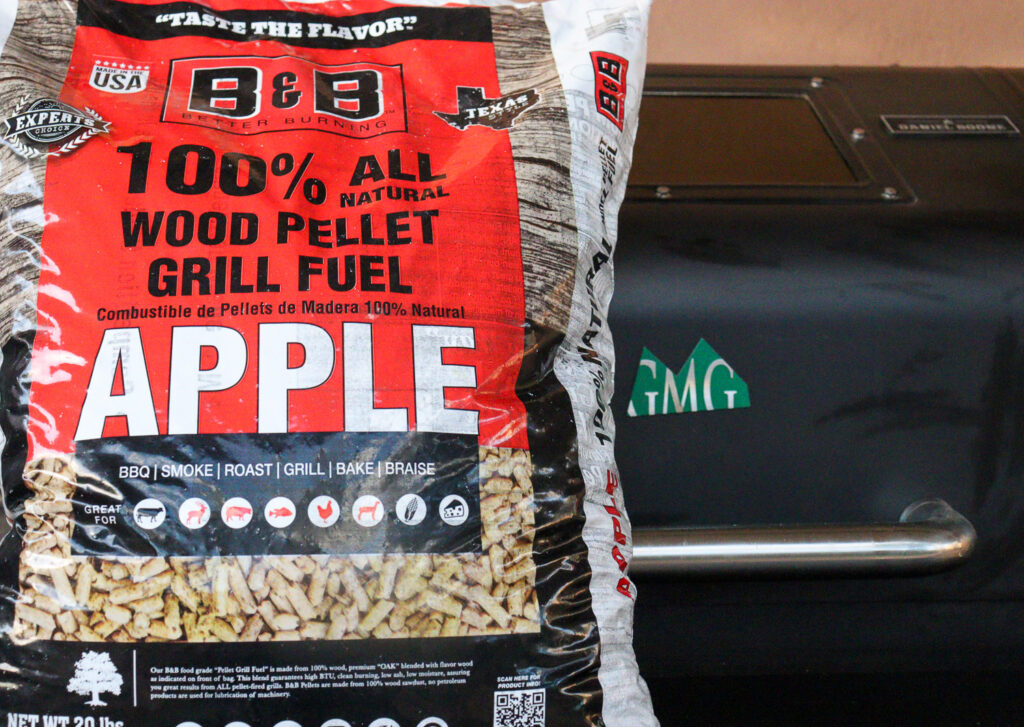
I’ve also had great results using a mixture of applewood and cherry wood for pork cooks so if you only have cherry wood laying around then that’s just as good.
While your smoker is coming up to temp it’s time to prepare your ribs.
2. Prepping the ribs
For this cook, I used two racks of baby back ribs.
Start by gathering your tools: a large chopping board, boning knife, paper towels, and a teaspoon (or butter knife).
- Pat them dry thoroughly with paper towels, then place the ribs bone-side up on the board.
- Remove the ribs from the packaging and give them a quick rinse under cold water to wash off any excess liquid.
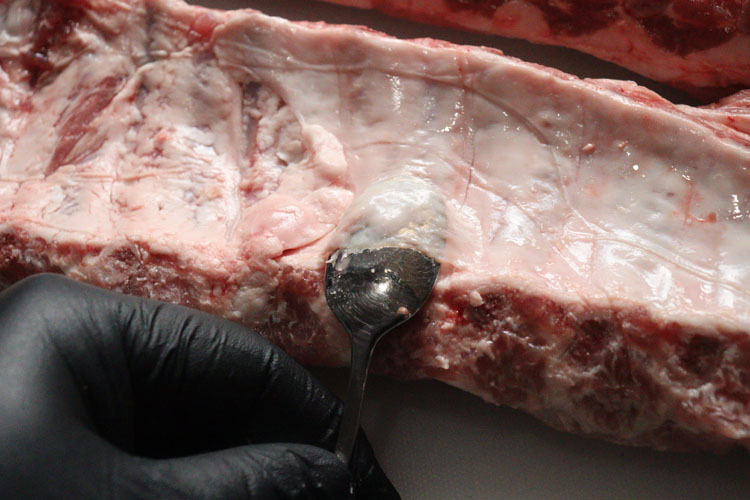
The membrane is reasonably tough but it pays to take it slow when sliding your spoon underneath.
The silver membrane on the back of the ribs is tough and chewy when cooked, so it’s best to remove it for better texture and flavor penetration.
If it tears, just start again at a new edge and keep going until it’s fully removed.
Pro Tip: Use the tip of a small spoon or knife to gently slide under the membrane between two bones, starting near the middle of the rack. Once you’ve worked the spoon underneath, lift gently to loosen the membrane.
Grip the loosened membrane with a paper towel (for better grip), then slowly peel it off.
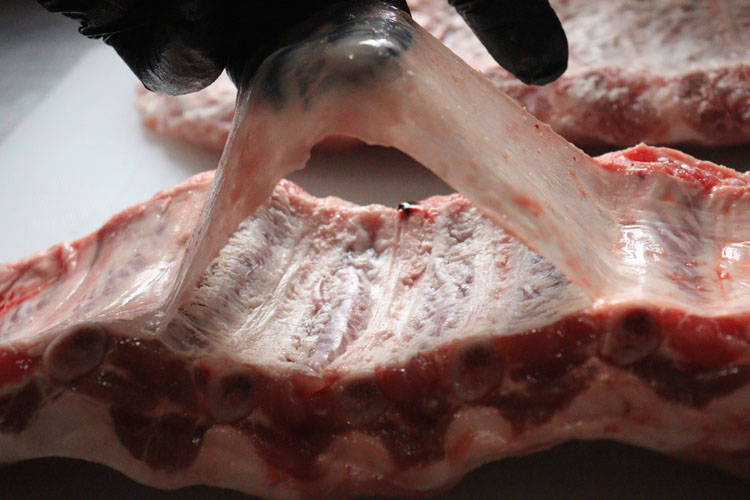
You can see by removing this membrane the meat underneath is exposed so you can get more flavor into it.
Flip the racks over and inspect the meat side. Use a boning knife to trim away any thick surface fat or ragged edges, leaving a bit of fat to render during cooking.
Once trimmed and cleaned up, your ribs should look tidy and ready for seasoning.
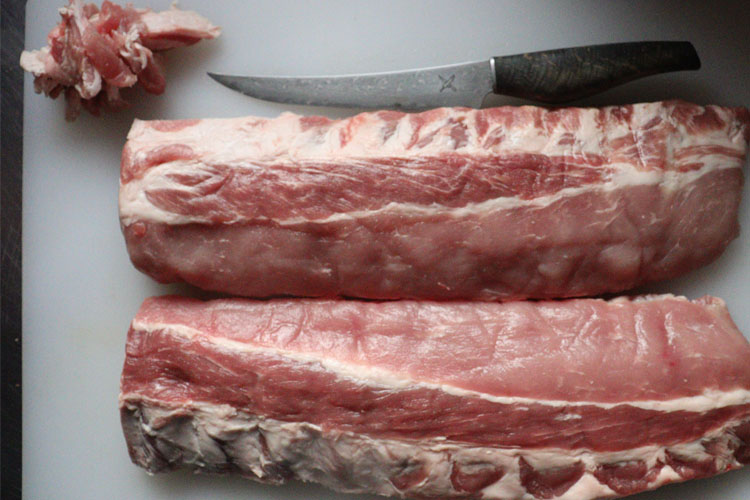
Looking pretty tidy.
3. Season the ribs
When it comes to pork ribs, I like to start with a good hit of sweetness, followed by black pepper, a touch of savory umami, and a slow-building spicy finish. That layered flavor profile gives ribs the kind of balanced punch that keeps you coming back for more.
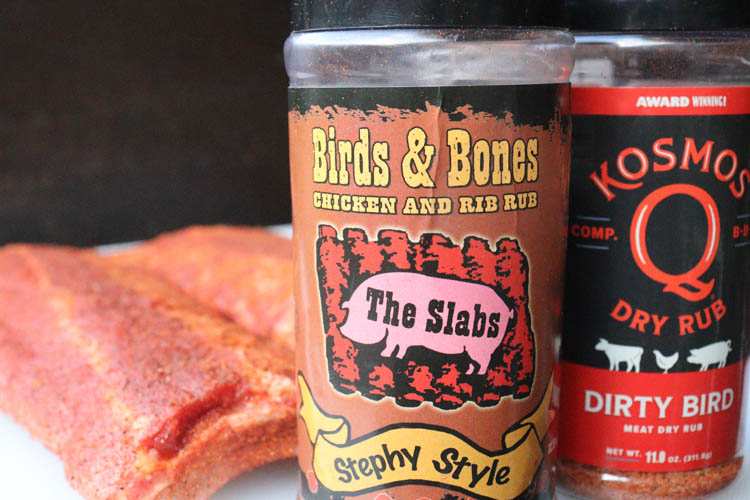
You can use an all-purpose rub or one specifically for pork, it’s more about the flavor profile you like.
You can use an all-purpose BBQ rub, a pork-specific blend, or even combine a few of your favorites to dial in your perfect flavor. For this cook, I used a combo of Birds & Bones Chicken and Rib Rub and Kosmos Q Dirty Bird, which brings a savory kick with a touch of heat.
No rubs on hand? Try our Ultimate BBQ Rib Rub — it’s designed to hit all the right notes: sweet, spicy, and competition-ready. You can also check out our complete list of BBQ rub recipes for more options.
While some folks use mustard or hot sauce as a binder, I find baby back ribs usually have enough surface moisture to apply rub directly.
- Start bone-side up, and apply an even coat of your rub of choice across the back and sides.
- If you’re layering multiple rubs, follow with a layer of the second rub (in my case Kosmos Dirty Bird for added depth and color).
- Flip the ribs meat-side up, and repeat the process with both rubs, covering the top and edges evenly.
Once seasoned, let the ribs rest for about 15 minutes. The rubs will start to absorb into the surface and take on a slightly wet, tacky appearance — that’s exactly what you want before they hit the smoker.
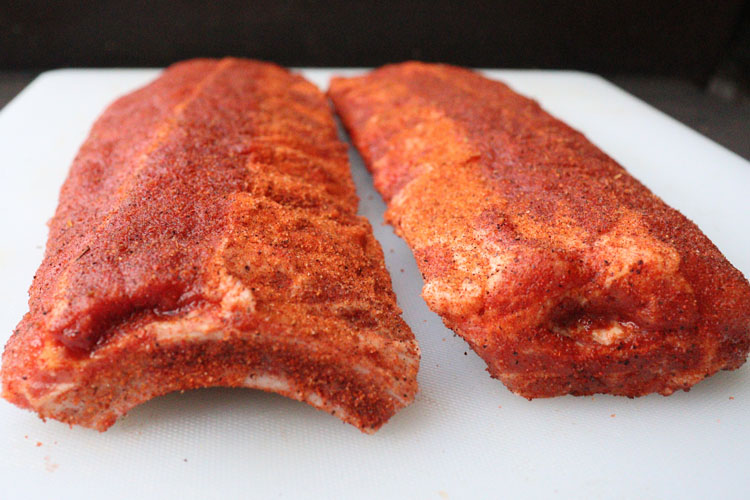
By the end of the 15 minutes and you can see the ribs have a wet look about them.
4. Initial smoke
Once your smoker is holding steady at 300°F, place the ribs on the grill, meat-side up, with some space between each rack for airflow. Let them smoke for about 1 hour.
After the first hour, check how the bark is developing. If the ribs look dry in spots, lightly spritz with apple juice. I usually skip this step when cooking hot and fast, especially with well-marbled ribs — they tend to stay moist on their own.
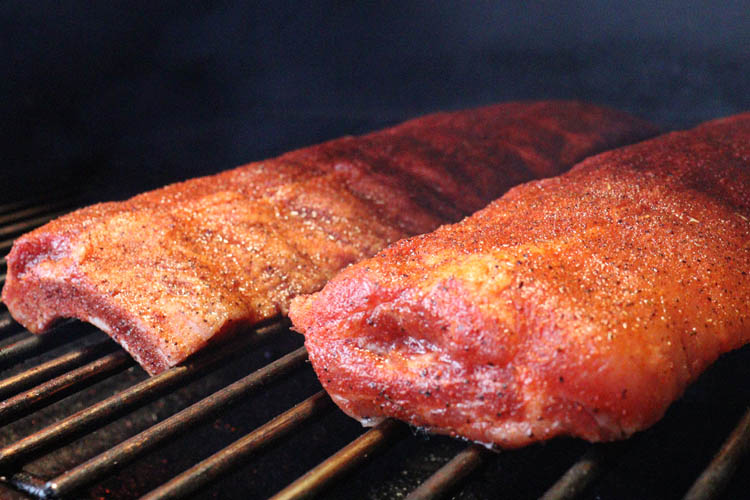
Ribs fresh on the smoker
💡 Cook to color, not time. I don’t follow the 3-2-1 method — instead, I look for a deep mahogany bark, where the rub begins to caramelize with the fat and meat. That’s when it’s time to wrap.
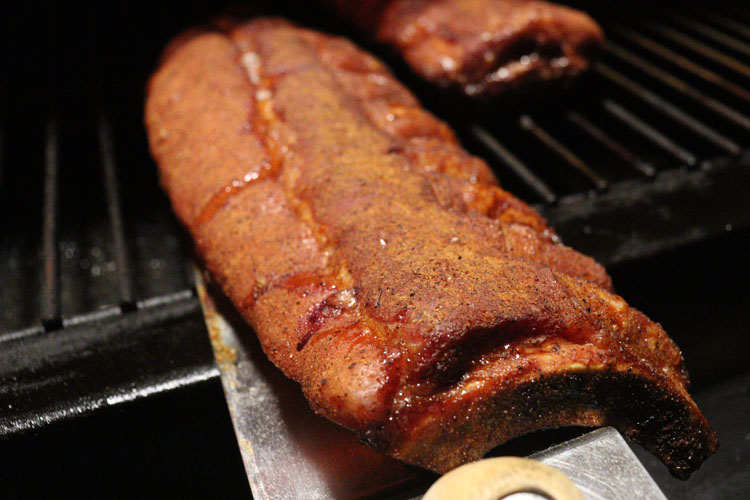
This reddish-brown color is what we mean by ‘mahogany’.
5. Wrap the ribs
When you’re happy with the bark, lay out two layers of heavy-duty aluminum foil, turning up the edges to catch any liquid.
For each rack:
- Drizzle honey across the foil in a zig-zag pattern
- Sprinkle brown sugar evenly over the honey
- Pour in a splash of apple juice
- Place the ribs meat-side down
- Repeat the honey/sugar/juice combo on the bone side
- Top with a few slices of unsalted butter
Wrap the ribs tightly, sealing well and avoiding sharp bones poking through. Return them to the smoker, still at 300°F.
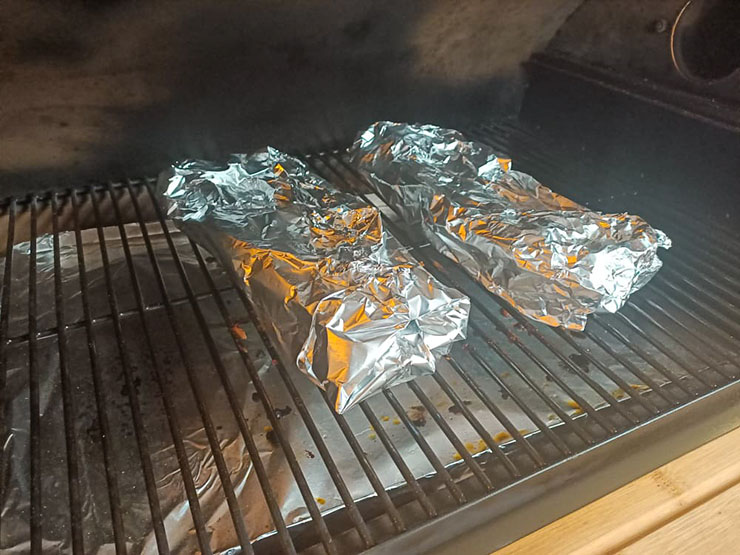
Here’s where heavy duty aluminium foil is handy, you don’t want the bones breaking through.
While the ribs are wrapped and back on the smoker, make your finishing glaze:
In a small saucepan over low heat, combine:
Stir constantly until warm and smooth. Don’t overheat — too much heat can make the sauce bitter. Set aside until the ribs are ready.
5. Glaze the ribs
After 1 hour wrapped, check the ribs. Carefully open the foil and use an instant-read thermometer or probe test between the bones:
- For ribs with a bite (tender but not falling apart), the probe should slide in with slight resistance.
- For fall-off-the-bone ribs, it should glide in like butter with no resistance.
You can also use the bend test: lift the rack from the middle with tongs — it should bend easily and droop without tearing apart (or break, if fully fall-off-the-bone).
When the ribs are at your preferred doneness:
- Fold back the foil and brush a generous layer of BBQ glaze on the bone side
- Flip the rack carefully and glaze the meat side
Return the ribs to the smoker for 15 minutes, uncovered, to allow the sauce to set and caramelize.
5. Serving your ribs
Place the ribs meat side down on your chopping board. Cut between each of the bones with a good slicing knife, use heat-proof gloves if required.
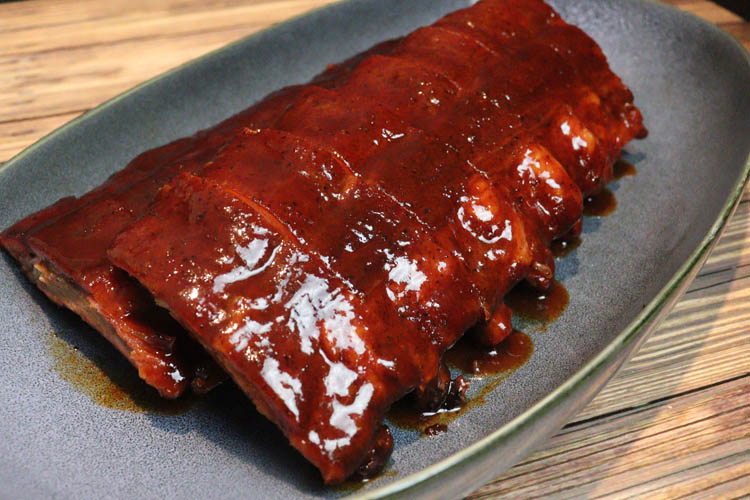
Get the napkins ready for these!
Apply a thin coating of your bbq sauce to the back of the ribs. Carefully flip each of the bones over, re-sauce the top of the ribs and in-between each of the cuts for added flavor.
Serve and enjoy.
Tips and FAQs for smoking ribs hot and fast
- Look for good marbling when buying ribs – Well-marbled baby backs stay juicy and flavorful. Avoid racks with excessive loin meat, which can dry out when overcooked.
- Do you really need to remove the membrane? – Yes — it’s tough to chew and acts as a barrier to smoke and seasoning. Taking a minute to remove it pays off in both flavor and texture.
- Cook at 300°F for hot and fast – This temp helps render fat quickly, builds bark, and still allows for smoke penetration in the early stages of the cook.
- Cook to color, not just time – Skip the rigid 3-2-1 method. Instead, cook based on how the ribs look and feel. You’re aiming for a deep mahogany bark before wrapping.
- Want to use spare ribs? – You can, but they’ll need more time — usually an extra 30–45 minutes. Baby backs are better suited to this quicker method.
What to serve with these quick smoked ribs
These ribs smoke so fast you won’t have time to prepare a lot of complicated sides. Keep it simple with these easy BBQ sides.
Some more rib recipes you might like to try
Hot and Fast Ribs Recipe
Craving juicy, tender ribs without the long wait? These sticky glazed hot ‘n fast pellet grill ribs are ready in under 3 hours perfect for a quick BBQ fix. Sure, they won’t win a KCBS competition, but they’ll blow minds at a backyard cookout.
Give these ribs a try and don’t forget to leave a 5-star rating if you loved the recipe. And if you love barbecue in half the time check out our hot and fast pulled pork and hot and fast brisket as well.
Print
Hot n’ Fast Pork Ribs on a Pellet Grill
Tender, juicy baby back ribs, smoked on the pellet grill and coated with a sticky BBQ sauce glaze.
Course Main Course
Cuisine American
Prep Time 15 minutes minutes
Cook Time 2 hours hours 45 minutes minutes
Total Time 3 hours hours
Servings 4
Calories 1334kcal
Author Joe Clements
- 2 racks Baby back ribs
- 4 tbsp Pork rub Aim for 2-3 tablespoons of rub per rack, or enough to get an even coverage across all sides.
For wrapping the ribs
- ¼ cup Apple Juice
- 3 tbsp brown sugar
- 2 tbsp honey
- 2.5 oz unsalted butter cut into 3 pieces
For the rib glaze
- 20 oz BBQ Sauce homemade or store brought
- 1 tbsp butter
- 1 tbsp honey or to taste
Preheat your smoker to 300°F.
Remove the ribs from the packaging, rinse under cold water, and pat dry with paper towels.
Remove the membrane from the bone side using a spoon and paper towel for grip, then trim any excess fat or loose meat from the top.
Season both sides of the ribs evenly with your preferred dry rub and let them rest for 15 minutes.
Place the ribs in the smoker, meat-side up, with space between each rack for even airflow.
After 1 hour, check the bark; if dry in spots, lightly spritz with apple juice. Continue cooking for another 30 to 45 minutes, or until a deep mahogany bark has developed.
Lay out two sheets of heavy-duty foil with the edges turned up. Drizzle honey, sprinkle brown sugar, and pour apple juice in a line across the foil.
Place the ribs meat-side down on the foil, repeat the honey, sugar, and juice on the back, then top with a few slices of butter.
Wrap tightly, avoiding air pockets or bone tears, and return to the smoker for 1 hour.
While the ribs are cooking, warm your BBQ glaze by combining BBQ sauce, butter, and honey in a saucepan over low heat, stirring until smooth.
After 1 hour, unwrap the ribs and check for tenderness using a probe or bend test. When done to your liking, fold back the foil and glaze both sides.
Return to the smoker for 15 minutes to set the glaze, then remove and rest the ribs before slicing and serving.
Calories: 1334kcal | Carbohydrates: 129g | Protein: 61g | Fat: 69g | Saturated Fat: 29g | Trans Fat: 1g | Cholesterol: 241mg | Sodium: 1749mg | Potassium: 1480mg | Fiber: 8g | Sugar: 81g | Vitamin A: 2467IU | Vitamin C: 8mg | Calcium: 739mg | Iron: 24mg
 Backyard GrillingWeekend WarriorsAdvice from DadBeard GroomingTV Shows for Guys4x4 Off-Road CarsMens FashionSports NewsAncient Archeology World NewsPrivacy PolicyTerms And Conditions
Backyard GrillingWeekend WarriorsAdvice from DadBeard GroomingTV Shows for Guys4x4 Off-Road CarsMens FashionSports NewsAncient Archeology World NewsPrivacy PolicyTerms And Conditions
